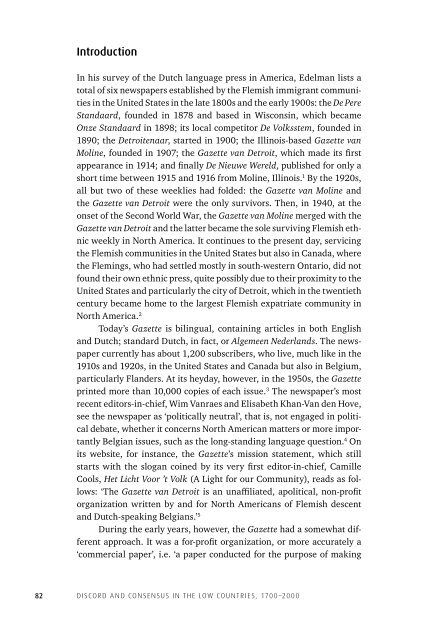Discord Consensus
7aze300jFJo
7aze300jFJo
You also want an ePaper? Increase the reach of your titles
YUMPU automatically turns print PDFs into web optimized ePapers that Google loves.
Introduction<br />
In his survey of the Dutch language press in America, Edelman lists a<br />
total of six newspapers established by the Flemish immigrant communities<br />
in the United States in the late 1800s and the early 1900s: the De Pere<br />
Standaard, founded in 1878 and based in Wisconsin, which became<br />
Onze Standaard in 1898; its local competitor De Volksstem, founded in<br />
1890; the Detroitenaar, started in 1900; the Illinois-based Gazette van<br />
Moline, founded in 1907; the Gazette van Detroit, which made its first<br />
appearance in 1914; and finally De Nieuwe Wereld, published for only a<br />
short time between 1915 and 1916 from Moline, Illinois. 1 By the 1920s,<br />
all but two of these weeklies had folded: the Gazette van Moline and<br />
the Gazette van Detroit were the only survivors. Then, in 1940, at the<br />
onset of the Second World War, the Gazette van Moline merged with the<br />
Gazette van Detroit and the latter became the sole surviving Flemish ethnic<br />
weekly in North America. It continues to the present day, servicing<br />
the Flemish communities in the United States but also in Canada, where<br />
the Flemings, who had settled mostly in south-western Ontario, did not<br />
found their own ethnic press, quite possibly due to their proximity to the<br />
United States and particularly the city of Detroit, which in the twentieth<br />
century became home to the largest Flemish expatriate community in<br />
North America. 2<br />
Today’s Gazette is bilingual, containing articles in both English<br />
and Dutch; standard Dutch, in fact, or Algemeen Nederlands. The newspaper<br />
currently has about 1,200 subscribers, who live, much like in the<br />
1910s and 1920s, in the United States and Canada but also in Belgium,<br />
particularly Flanders. At its heyday, however, in the 1950s, the Gazette<br />
printed more than 10,000 copies of each issue. 3 The newspaper’s most<br />
recent editors-in-chief, Wim Vanraes and Elisabeth Khan-Van den Hove,<br />
see the newspaper as ‘politically neutral’, that is, not engaged in political<br />
debate, whether it concerns North American matters or more importantly<br />
Belgian issues, such as the long-standing language question. 4 On<br />
its website, for instance, the Gazette’s mission statement, which still<br />
starts with the slogan coined by its very first editor-in-chief, Camille<br />
Cools, Het Licht Voor ’t Volk (A Light for our Community), reads as follows:<br />
‘The Gazette van Detroit is an unaffiliated, apolitical, non-profit<br />
organization written by and for North Americans of Flemish descent<br />
and Dutch-speaking Belgians.’ 5<br />
During the early years, however, the Gazette had a somewhat different<br />
approach. It was a for-profit organization, or more accurately a<br />
‘commercial paper’, i.e. ‘a paper conducted for the purpose of making<br />
82<br />
DISCORD AND CONSENSUS IN THE LOW COUNTRIES, 1700–2000


